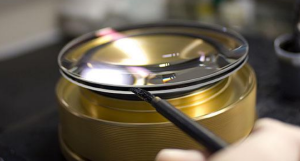After optical lenses are finely ground with grinding fluid, there is still a crack layer about 2-3m thick on their surface. The method to eliminate this crack layer is polishing. The mechanism of polishing and grinding is the same, except that the tool material used is different from the polishing fluid (slurry). The materials used for polishing include cloth, polyurethane, and pitch, usually to achieve a high-precision polishing surface. The commonly used material is high-grade polishing asphalt.
Optical lenses are polished using asphalt, which drives the polishing fluid to grind the surface of the lens and generate heat, melting and flowing the glass, removing rough vertices and filling the valley of cracks, gradually removing the crack layer. At present, the polishing powder used for polishing glass lenses is mainly cerium oxide (CeO2), and the proportion of polishing solution preparation varies depending on the polishing period of the lens. Generally, a higher concentration of polishing solution is used during the initial polishing stage and when the polishing mold is combined. After the surface of the lens is bright, a thinner concentration of polishing solution is used to avoid the phenomenon of orange peel on the mirror surface (atomization on the mirror surface).
The motion mechanism used for polishing and grinding is the same. In addition to the different polishing tools and working fluids, the environmental conditions required for polishing are also more stringent than those for grinding. The following precautions should be taken during general polishing: there should be no impurities on the surface of the polishing asphalt and the polishing liquid, otherwise it may cause scratches on the mirror surface. The polished asphalt surface should match the surface of the lens, otherwise there will be bouncing during polishing, resulting in biting the polishing powder and scratching the surface of the lens.
Before polishing, it is necessary to determine whether there are scratches or punctures left on the surface of the lens after grinding. Is the size and material of the polishing tool appropriate. Is the softness, hardness, and thickness of asphalt appropriate. During the polishing process, attention must be paid to the condition and accuracy check of the lens surface at all times. The inspection of lens surface defects is based on personal vision and methods, so inspectors should have a deep understanding of the specifications of scratches and sand holes. They should frequently compare the standard samples of scratches and sand holes to ensure the correctness of the inspection.




